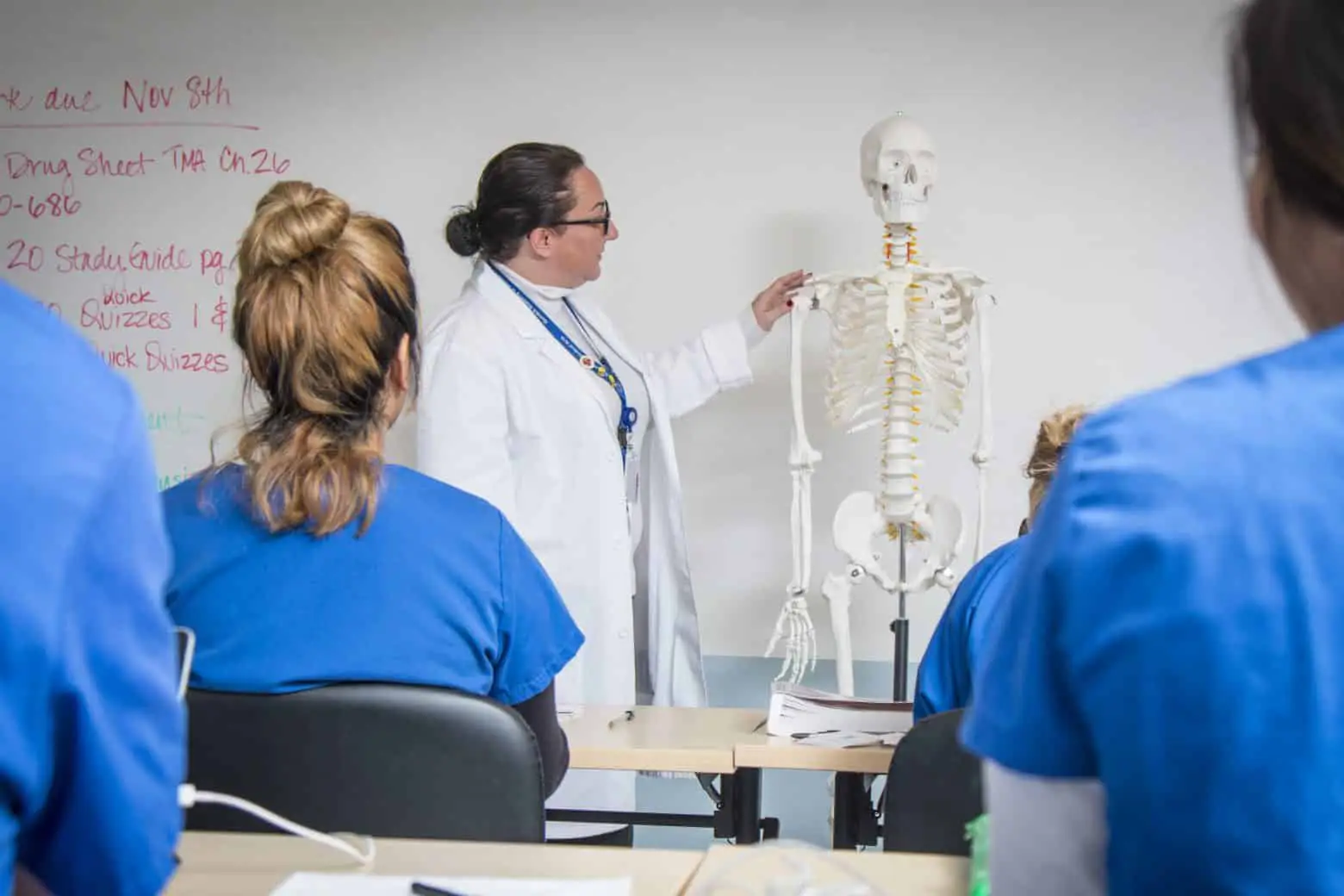5 Steps to Become a Registered Nurse in California
Date: October 6, 2023
Becoming a Registered Nurse (RN) begins with tiny—yet ongoing steps. The first step is obtaining a solid academic foundation. At the base of the educational continuum, one must obtain a high school diploma or G.E.D. Accordingly, your secondary education should include anatomy and physiology, biology, microbiology, and chemistry classes. Consider taking English composition, lifespan growth, and development, nutrition, psychology, and statistics.1 Similarly, taking a foreign language is highly recommended.
Step One: Obtain a Solid Academic Foundation
According to NurseJournal, these classes add the following values for future nurses. For ease, we’ve unpacked them below:
- Anatomy and Physiology—Briefly, A&P introduces future nurses to basic terminology, including the human skeletal, muscular, and nervous systems and the impact of diseases.1
- Biology—Specifically, this covers kingdoms of life, cell structure, taxonomy, reproduction, ecology, and intro to genetics.1
- Microbiology—In brief, the course provides fundamentals of microorganisms, such as bacteria, fungi, and parasites.1
- Chemistry—Specifically, the course helps establish processes within the human body at the cellular level.1
- English Composition—Generally, most nursing programs require two semesters of English composition or a similar writing course.1
- Lifespan Growth and Development—To sum this class up, it provides an overview of human growth from conception to death and how human beings change over their lifespan.1
- Nutrition—By and large, this course gives one a firm grounding in nutritional science and understanding the dietary principles that impact patient care quality.1
- Psychology—Similarly, this class focuses on human growth and development, behavior, learning, memory, and intelligence.1
Statistics—Specifically, this course helps nurses apply evidence-based practices in patient care delivery. Further, it prepares students to identify patterns in vital signs and symptoms. Additionally, students learn to adjust the dosage of medications and evaluate the effectiveness of treatments.1
Step Two: Read Nursing Materials
The second step is to read everything you can about the nursing profession–the good, the bad, the humorous, the ugly. Try nursing journals, blogs, and academic textbooks, and of course, do an extensive Google search for Internet nursing articles. You might want to talk to nurses in the profession or retired professionals. If reading time isn’t something you routinely put in your schedule, try a podcast. Popular and accessible podcasts provide a plethora of nursing topics, from the art of emergency nursing to the humorous antics of bedside manner.
Step Three: Find Your Program
The third step is to find your perfect program. To do this, start researching schools and the prerequisites required to get into them. If you need more credits, request your new college review your transcripts and credit grant where possible. If they won’t, don’t despair; often, required classes may be taken at your new campus.
While researching your program, remember multiple paths lead to nursing, with RN program trajectories in the following:
- Associate Degree in Nursing (A.D.N.)
- Associate of Science Degree in Nursing Program (A.S.N.)
- Associate of Applied Science in Nursing (A.A.S.)
- Bachelor of Science Degree in Nursing (B.S.N.)
Registered Nurse (RN) Degree programs
Confused? Don’t sweat! We’ve summarily explained 101 RN routes below:
A) Associate Degree in Nursing (A.D.N.)
The A.D.N. or Associate Degree in Nursing program typically leads to an RN license, not a Vocational Nurse (VN). Depending on the curriculum and its structure, most A.D.N. courses require one to complete the entire two years and then apply for RN licensure, bypassing the VN route entirely.
- Focus: The A.D.N. focuses on comprehensive nursing courses and clinical practice.3
- Courses: Anatomy, physiology, administering medications, nutrition, psychology, microbiology, practical skills, bloodwork, starting I.V.s, bathing, toileting, and mealtimes. Foundations in nursing, nursing care of adults, behavioral health, maternal and child nursing.2
- Required: Clinical work and National Council Licensure Examination® (NCLEX®).
- Eligibility: Eligible to take the NCLEX® and obtain an RN license.3
B) Associate of Science Degree in Nursing Program (A.S.N.)
The A.S.N. or Associate of Science in Nursing degree leads to an RN license. Moreover, it combines coursework with hands-on experience so students may increase their knowledge and develop and improve the skills needed to excel as nurses post-graduation.4
- Focus: The A.S.N. focuses primarily on clinical practice while providing nursing courses.3 The A.S.N. places more emphasis on clinical tasks rather than academics. If you take this route, expect to spend more time completing clinicals in healthcare facilities and performing work in skills labs rather than attending lectures in the classroom. And that’s good news for students who prefer activity over classroom time.
- Courses: Some of the required credits are nursing-specific, while others are more general education-driven.4 Health assessment, medical-surgical nursing, pharmacology, nutrition, obstetrics/pediatric, mental health, NCLEX review, capstone clinical.2
- Required: Clinical work and National Council Licensure Examination® (NCLEX®).
- Eligibility: Eligible to take the NCLEX® and obtain an RN license.3
C) Associate of Applied Science in Nursing (A.A.S.)
Another two-year program, the A.A.S. or Associate of Applied Science in Nursing, provides students with an overview of nursing specializations while letting them explore various subjects.
- Focus: The A.A.S. is a career-focused degree program that provides primary nursing education.3 With a look at the “big picture,” nursing students gain the foundational knowledge to make informed choices regarding which department they want to work in. For instance, they may opt to work in a hospital or other patient population.4
- Courses: As with the A.D.N. and A.S.N. programs, the A.A.S. covers the nursing basics. Health and illness throughout the LifeSpan, fundamentals in nursing, adult nursing, therapeutic use of self, pharmacology, nursing process and documentation, nursing management, maternal/newborn self-care, psychosocial self-care, health deviations in childhood, and health deviations in older adulthood.2
- Required: Clinical work and National Council Licensure Examination® (NCLEX®).
- Eligibility: Eligible to take the NCLEX® and obtain an RN license.3
D) Bachelor of Science Degree in Nursing (B.S.N.)
The B.S.N. or Bachelor of Science Degree in Nursing is a four-year program. However, if you are already an RN and hold an associate degree, the RN-to-B.S.N. transition can be finished sooner.
- Focus: “The broad focus of BSN programs is one way they prepare students to pursue advanced nursing degrees. Students also gain critical thinking, communication, and leadership skills, which help them make nursing diagnoses, plan patient care, and evaluate nursing interventions. Several factors also contribute to the value of a BSN.”5
- Courses: Anatomy and physiology, microbiology, nutrition, emergency care, statistics, psychology/anthropology, pharmacology, health assessment, family, community, and population-based care, public and global health, nursing theory, nursing research, nursing ethics.6
- Required: Clinical work and National Council Licensure Examination® (NCLEX®).
- Eligibility: Eligible to take the NCLEX® and obtain an RN license.
Another alternative option is an LVN to RN Bridge Program—an ideal career-oriented course from 15–18 months for VN licensure in California. Upon completing our VN program, one can progress to RN licensure.
Step Five: Enroll and Complete Some Red Tape
College acceptance can take days, weeks, months, or even up to a year. Moreover, with all RN programs, one should talk with an admissions advisor. Let these professionals ease you through the registration process. For most institutions, this represents a “well-oiled machine.”
While colleges have different admissions policies, grade thresholds, and entrance requirements, you’ll want to familiarize yourself with your new school’s regulations, needed documentation, and hard and fast enrollment deadlines. Other admissions items to consider include:
- Clarifying your college’s GPA threshold for acceptance against your academic history.
- Knowing the entrance exams your future college conducts. For instance, do they require the CCAT, UCAT, TEAS, SAT, or ACT exams? Is there any other testing, such as language skills assessments, aka English test as Foreign Language (TOEFL)? If you’re an international student, what evaluation will be required of your documents?
- If you’re a California resident, upon program finish, licensure is required from the California State Board of Registered Nursing.
- Have you committed any crimes? Upon finishing a nursing program, you must pass a criminal background check.
For reference ease, Gurnick Academy’s Nursing Admission Point System is found on this page.
We’ve Got a Nursing Program For You
Finally, whether you want just a solid overview of nursing roles or a more clinical focus, we’ve got you covered. If you prefer the big aerial picture of the vocation or want to get into the “weeds” of all that nursing entails, we have a class! If you’re seeking a well-rounded nursing education, we have the trajectory. By contrast, if you must be work-ready and fast, we have said program. Ultimately, whatever your nursing goals, we have options.
At last, check out our array of nursing choices today.~
Citations
1^a, b, c, d, e, f, g, h, i Gleason, Brandy. “What Are the Prerequisites for Nursing School?|NurseJournal.org.” NurseJournal. July 15, 2021. (Accessed Sept. 25, 2023.)
2 —. “What Are the Differences Between A.D.N., A.S.N. and A.A.S. Nursing Degrees?” Nurse.org. July 12, 2023. (Accessed Sept. 27, 2023.)
3^a, b, c, d, e, f RN, Emily Tuttle. “A.D.N., A.S.N., and A.A.S. Nursing Degrees–What’s the Difference?” Incredible Health. Nov. 16, 2022. (Accessed Sept. 20, 2023.)
4 Indeed Editorial Team. “A.D.N. vs. A.S.N. vs. A.A.S. Nursing Degrees: What’re the Differences?” Indeed Career Guide. June 24, 2022. (Accessed Sept. 25, 2023.)
5 Hrelic, PhD, RNC, Debra. “RN to BSN: Why and How.” American Nurse. Oct. 7, 2019. (Accessed Sept. 27, 2023.)
6 “Bachelor of Science in Nursing (BSN) Degrees.” Nursing License Map. Jan. 2022. Sept. 2023. (Accessed Sept. 27, 2023.)




